Statistics Homework: Analysis of Variance, Regression, and Forecasting
VerifiedAdded on 2020/05/16
|9
|1719
|50
Homework Assignment
AI Summary
This statistics homework assignment covers a range of statistical concepts, including ANOVA (Analysis of Variance), linear regression, and forecasting techniques. The solutions presented address various scenarios, such as analyzing the impact of different treatments, predicting sales based on various factors, and calculating moving averages. The assignment includes detailed calculations of F-statistics, p-values, and coefficients of determination to assess the statistical significance of relationships and the accuracy of predictive models. Furthermore, the assignment explores hypothesis testing to determine the validity of claims and uses moving averages to forecast trends. The solutions also cover the interpretation of regression coefficients and the application of statistical tools to real-world business problems. The assignment delves into the calculation of mean square error and mean absolute deviation to assess the accuracy of forecasting models. Overall, the assignment provides a comprehensive overview of statistical methods and their applications.
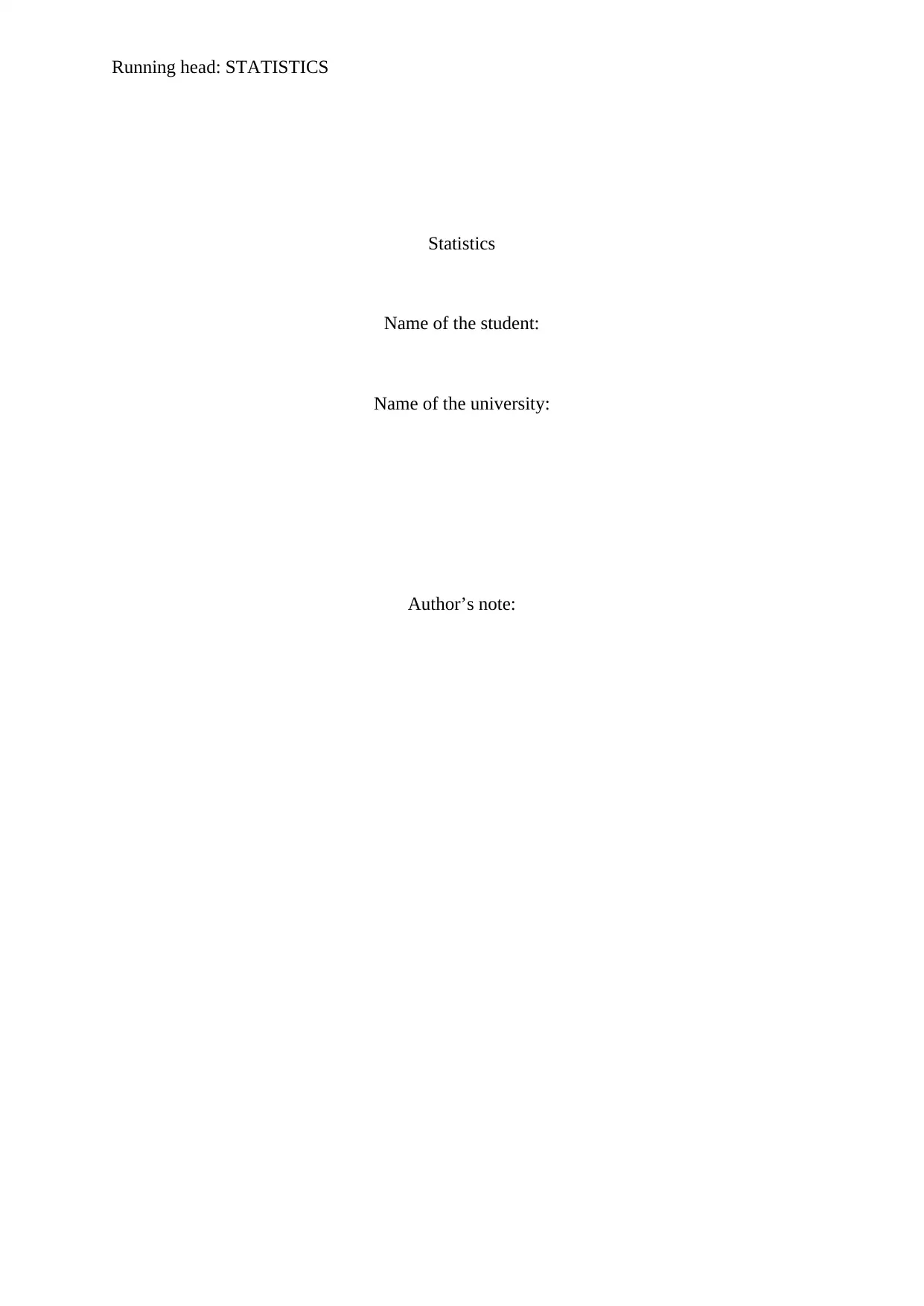
Running head: STATISTICS
Statistics
Name of the student:
Name of the university:
Author’s note:
Statistics
Name of the student:
Name of the university:
Author’s note:
Paraphrase This Document
Need a fresh take? Get an instant paraphrase of this document with our AI Paraphraser
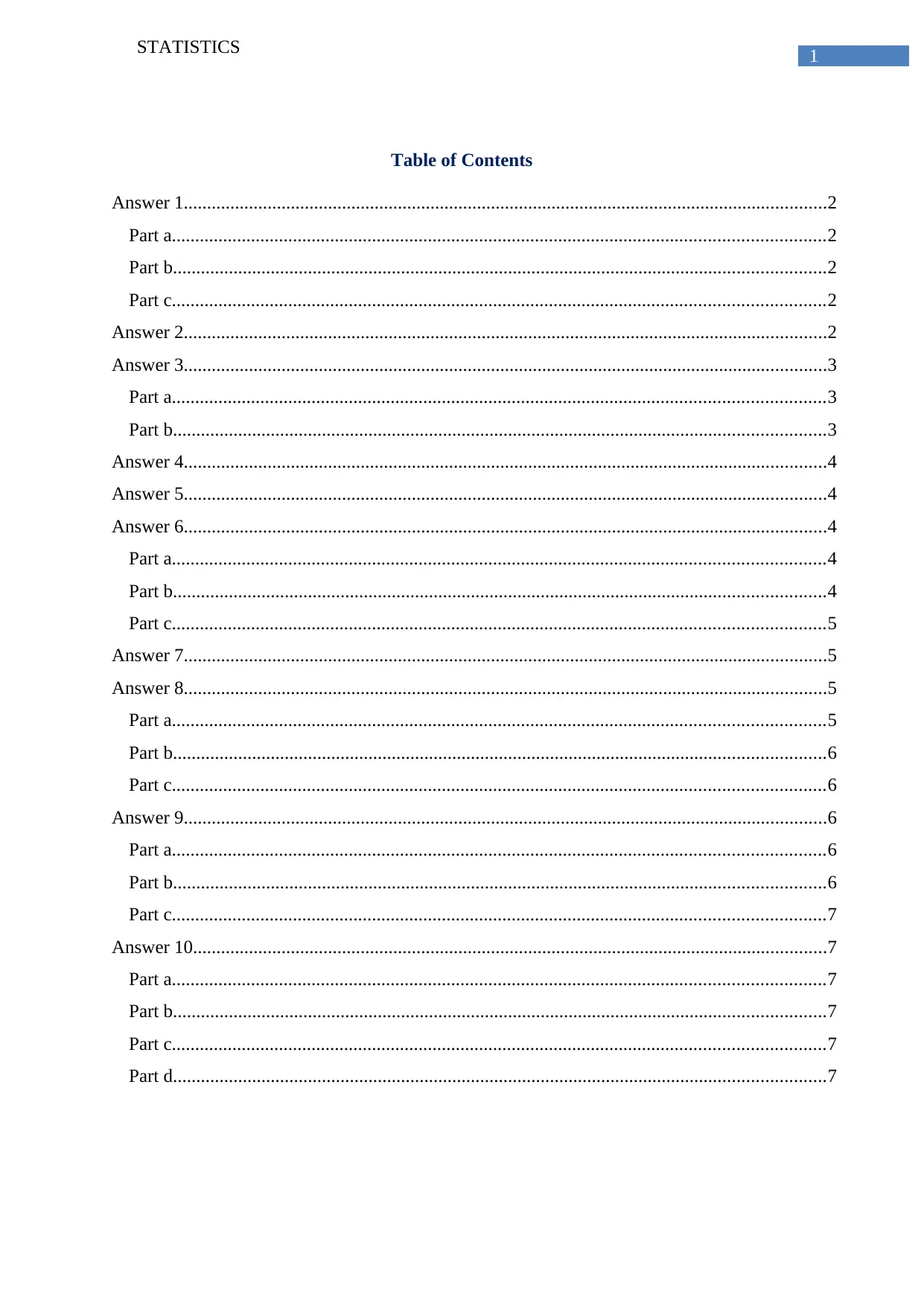
1STATISTICS
Table of Contents
Answer 1..........................................................................................................................................2
Part a............................................................................................................................................2
Part b............................................................................................................................................2
Part c............................................................................................................................................2
Answer 2..........................................................................................................................................2
Answer 3..........................................................................................................................................3
Part a............................................................................................................................................3
Part b............................................................................................................................................3
Answer 4..........................................................................................................................................4
Answer 5..........................................................................................................................................4
Answer 6..........................................................................................................................................4
Part a............................................................................................................................................4
Part b............................................................................................................................................4
Part c............................................................................................................................................5
Answer 7..........................................................................................................................................5
Answer 8..........................................................................................................................................5
Part a............................................................................................................................................5
Part b............................................................................................................................................6
Part c............................................................................................................................................6
Answer 9..........................................................................................................................................6
Part a............................................................................................................................................6
Part b............................................................................................................................................6
Part c............................................................................................................................................7
Answer 10........................................................................................................................................7
Part a............................................................................................................................................7
Part b............................................................................................................................................7
Part c............................................................................................................................................7
Part d............................................................................................................................................7
Table of Contents
Answer 1..........................................................................................................................................2
Part a............................................................................................................................................2
Part b............................................................................................................................................2
Part c............................................................................................................................................2
Answer 2..........................................................................................................................................2
Answer 3..........................................................................................................................................3
Part a............................................................................................................................................3
Part b............................................................................................................................................3
Answer 4..........................................................................................................................................4
Answer 5..........................................................................................................................................4
Answer 6..........................................................................................................................................4
Part a............................................................................................................................................4
Part b............................................................................................................................................4
Part c............................................................................................................................................5
Answer 7..........................................................................................................................................5
Answer 8..........................................................................................................................................5
Part a............................................................................................................................................5
Part b............................................................................................................................................6
Part c............................................................................................................................................6
Answer 9..........................................................................................................................................6
Part a............................................................................................................................................6
Part b............................................................................................................................................6
Part c............................................................................................................................................7
Answer 10........................................................................................................................................7
Part a............................................................................................................................................7
Part b............................................................................................................................................7
Part c............................................................................................................................................7
Part d............................................................................................................................................7
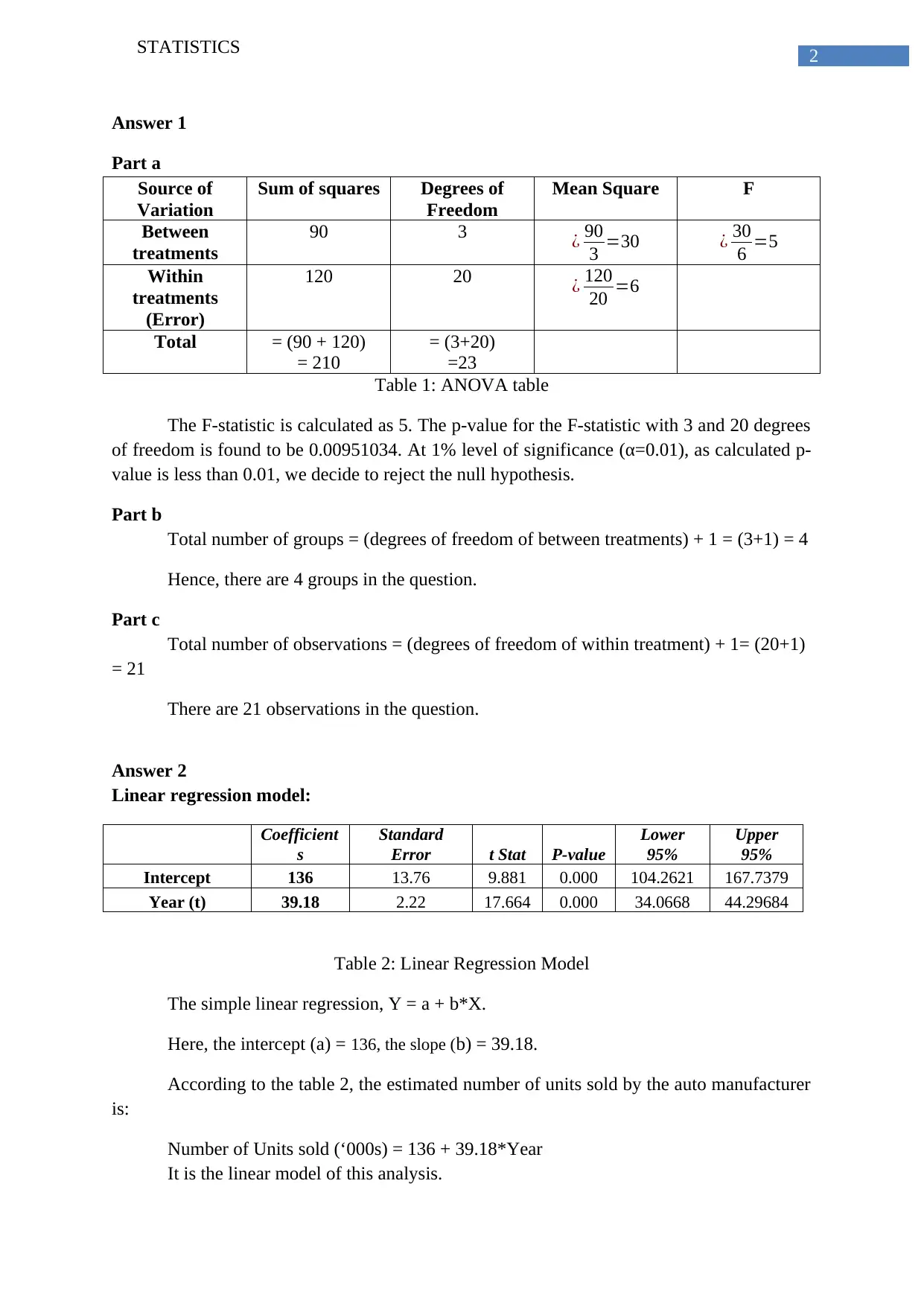
2STATISTICS
Answer 1
Part a
Source of
Variation
Sum of squares Degrees of
Freedom
Mean Square F
Between
treatments
90 3 ¿ 90
3 =30 ¿ 30
6 =5
Within
treatments
(Error)
120 20 ¿ 120
20 =6
Total = (90 + 120)
= 210
= (3+20)
=23
Table 1: ANOVA table
The F-statistic is calculated as 5. The p-value for the F-statistic with 3 and 20 degrees
of freedom is found to be 0.00951034. At 1% level of significance (α=0.01), as calculated p-
value is less than 0.01, we decide to reject the null hypothesis.
Part b
Total number of groups = (degrees of freedom of between treatments) + 1 = (3+1) = 4
Hence, there are 4 groups in the question.
Part c
Total number of observations = (degrees of freedom of within treatment) + 1= (20+1)
= 21
There are 21 observations in the question.
Answer 2
Linear regression model:
Coefficient
s
Standard
Error t Stat P-value
Lower
95%
Upper
95%
Intercept 136 13.76 9.881 0.000 104.2621 167.7379
Year (t) 39.18 2.22 17.664 0.000 34.0668 44.29684
Table 2: Linear Regression Model
The simple linear regression, Y = a + b*X.
Here, the intercept (a) = 136, the slope (b) = 39.18.
According to the table 2, the estimated number of units sold by the auto manufacturer
is:
Number of Units sold (‘000s) = 136 + 39.18*Year
It is the linear model of this analysis.
Answer 1
Part a
Source of
Variation
Sum of squares Degrees of
Freedom
Mean Square F
Between
treatments
90 3 ¿ 90
3 =30 ¿ 30
6 =5
Within
treatments
(Error)
120 20 ¿ 120
20 =6
Total = (90 + 120)
= 210
= (3+20)
=23
Table 1: ANOVA table
The F-statistic is calculated as 5. The p-value for the F-statistic with 3 and 20 degrees
of freedom is found to be 0.00951034. At 1% level of significance (α=0.01), as calculated p-
value is less than 0.01, we decide to reject the null hypothesis.
Part b
Total number of groups = (degrees of freedom of between treatments) + 1 = (3+1) = 4
Hence, there are 4 groups in the question.
Part c
Total number of observations = (degrees of freedom of within treatment) + 1= (20+1)
= 21
There are 21 observations in the question.
Answer 2
Linear regression model:
Coefficient
s
Standard
Error t Stat P-value
Lower
95%
Upper
95%
Intercept 136 13.76 9.881 0.000 104.2621 167.7379
Year (t) 39.18 2.22 17.664 0.000 34.0668 44.29684
Table 2: Linear Regression Model
The simple linear regression, Y = a + b*X.
Here, the intercept (a) = 136, the slope (b) = 39.18.
According to the table 2, the estimated number of units sold by the auto manufacturer
is:
Number of Units sold (‘000s) = 136 + 39.18*Year
It is the linear model of this analysis.
⊘ This is a preview!⊘
Do you want full access?
Subscribe today to unlock all pages.

Trusted by 1+ million students worldwide
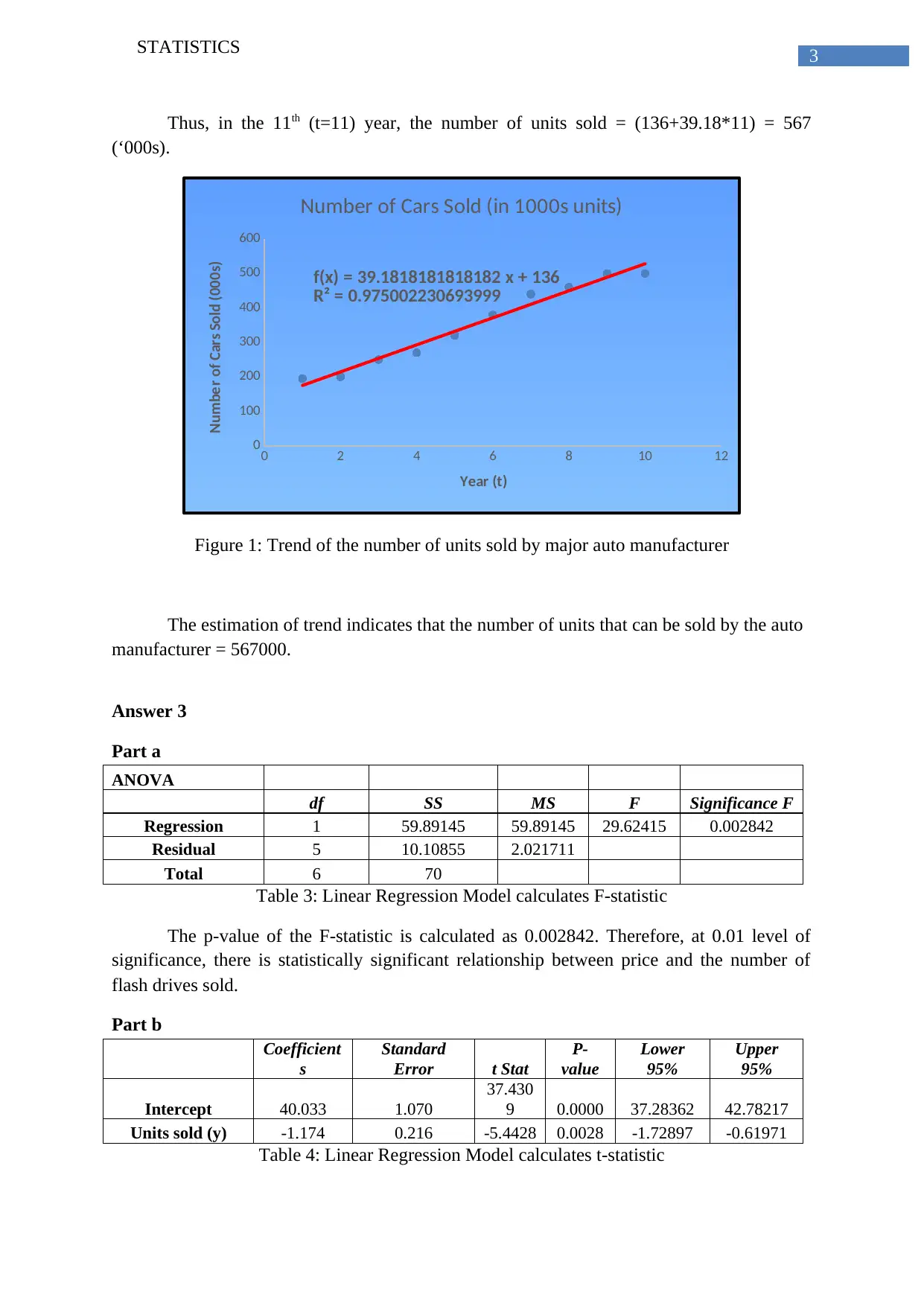
3STATISTICS
Thus, in the 11th (t=11) year, the number of units sold = (136+39.18*11) = 567
(‘000s).
0 2 4 6 8 10 12
0
100
200
300
400
500
600
f(x) = 39.1818181818182 x + 136
R² = 0.975002230693999
Number of Cars Sold (in 1000s units)
Year (t)
Number of Cars Sold (000s)
Figure 1: Trend of the number of units sold by major auto manufacturer
The estimation of trend indicates that the number of units that can be sold by the auto
manufacturer = 567000.
Answer 3
Part a
ANOVA
df SS MS F Significance F
Regression 1 59.89145 59.89145 29.62415 0.002842
Residual 5 10.10855 2.021711
Total 6 70
Table 3: Linear Regression Model calculates F-statistic
The p-value of the F-statistic is calculated as 0.002842. Therefore, at 0.01 level of
significance, there is statistically significant relationship between price and the number of
flash drives sold.
Part b
Coefficient
s
Standard
Error t Stat
P-
value
Lower
95%
Upper
95%
Intercept 40.033 1.070
37.430
9 0.0000 37.28362 42.78217
Units sold (y) -1.174 0.216 -5.4428 0.0028 -1.72897 -0.61971
Table 4: Linear Regression Model calculates t-statistic
Thus, in the 11th (t=11) year, the number of units sold = (136+39.18*11) = 567
(‘000s).
0 2 4 6 8 10 12
0
100
200
300
400
500
600
f(x) = 39.1818181818182 x + 136
R² = 0.975002230693999
Number of Cars Sold (in 1000s units)
Year (t)
Number of Cars Sold (000s)
Figure 1: Trend of the number of units sold by major auto manufacturer
The estimation of trend indicates that the number of units that can be sold by the auto
manufacturer = 567000.
Answer 3
Part a
ANOVA
df SS MS F Significance F
Regression 1 59.89145 59.89145 29.62415 0.002842
Residual 5 10.10855 2.021711
Total 6 70
Table 3: Linear Regression Model calculates F-statistic
The p-value of the F-statistic is calculated as 0.002842. Therefore, at 0.01 level of
significance, there is statistically significant relationship between price and the number of
flash drives sold.
Part b
Coefficient
s
Standard
Error t Stat
P-
value
Lower
95%
Upper
95%
Intercept 40.033 1.070
37.430
9 0.0000 37.28362 42.78217
Units sold (y) -1.174 0.216 -5.4428 0.0028 -1.72897 -0.61971
Table 4: Linear Regression Model calculates t-statistic
Paraphrase This Document
Need a fresh take? Get an instant paraphrase of this document with our AI Paraphraser
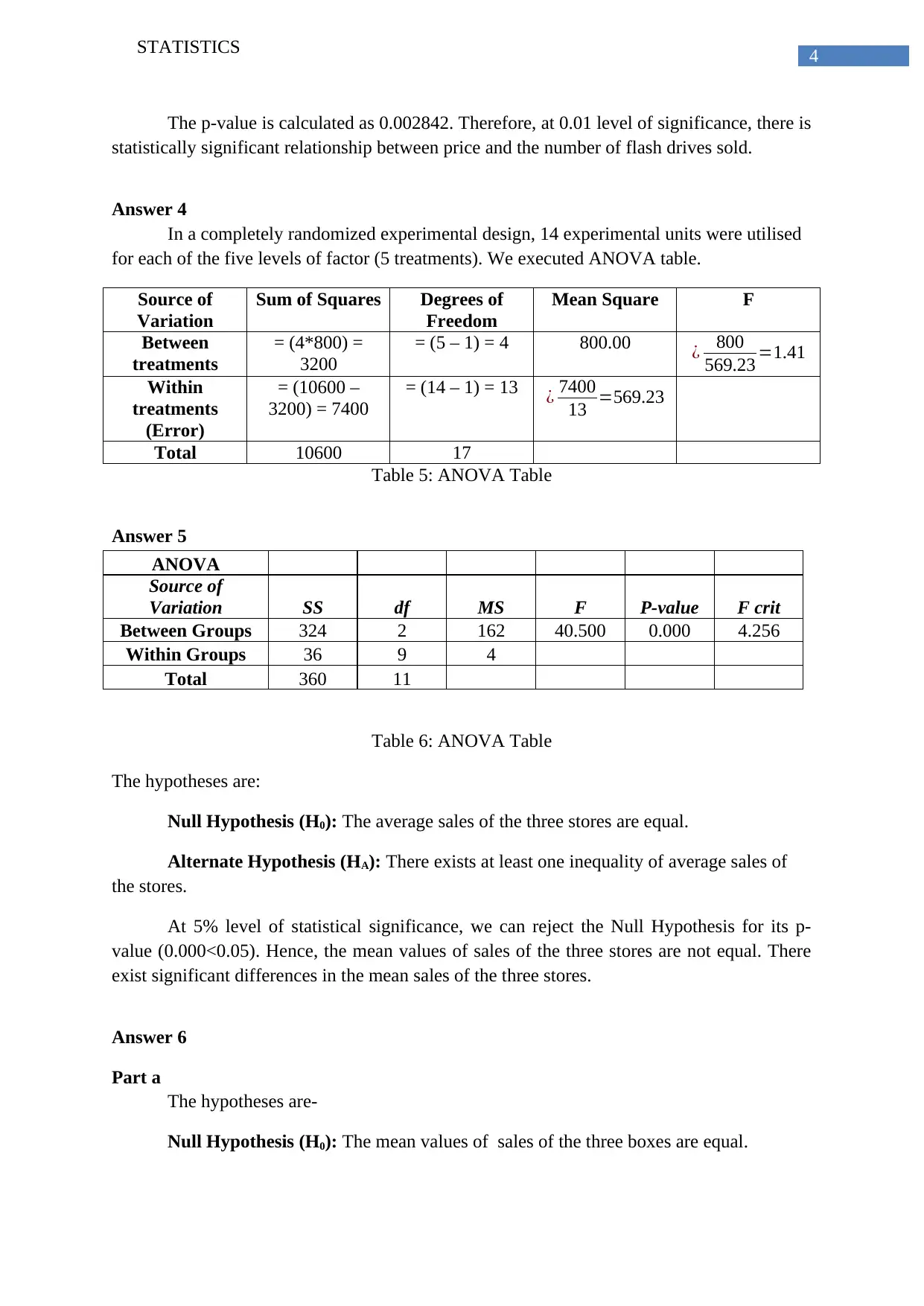
4STATISTICS
The p-value is calculated as 0.002842. Therefore, at 0.01 level of significance, there is
statistically significant relationship between price and the number of flash drives sold.
Answer 4
In a completely randomized experimental design, 14 experimental units were utilised
for each of the five levels of factor (5 treatments). We executed ANOVA table.
Source of
Variation
Sum of Squares Degrees of
Freedom
Mean Square F
Between
treatments
= (4*800) =
3200
= (5 – 1) = 4 800.00 ¿ 800
569.23 =1.41
Within
treatments
(Error)
= (10600 –
3200) = 7400
= (14 – 1) = 13 ¿ 7400
13 =569.23
Total 10600 17
Table 5: ANOVA Table
Answer 5
ANOVA
Source of
Variation SS df MS F P-value F crit
Between Groups 324 2 162 40.500 0.000 4.256
Within Groups 36 9 4
Total 360 11
Table 6: ANOVA Table
The hypotheses are:
Null Hypothesis (H0): The average sales of the three stores are equal.
Alternate Hypothesis (HA): There exists at least one inequality of average sales of
the stores.
At 5% level of statistical significance, we can reject the Null Hypothesis for its p-
value (0.000<0.05). Hence, the mean values of sales of the three stores are not equal. There
exist significant differences in the mean sales of the three stores.
Answer 6
Part a
The hypotheses are-
Null Hypothesis (H0): The mean values of sales of the three boxes are equal.
The p-value is calculated as 0.002842. Therefore, at 0.01 level of significance, there is
statistically significant relationship between price and the number of flash drives sold.
Answer 4
In a completely randomized experimental design, 14 experimental units were utilised
for each of the five levels of factor (5 treatments). We executed ANOVA table.
Source of
Variation
Sum of Squares Degrees of
Freedom
Mean Square F
Between
treatments
= (4*800) =
3200
= (5 – 1) = 4 800.00 ¿ 800
569.23 =1.41
Within
treatments
(Error)
= (10600 –
3200) = 7400
= (14 – 1) = 13 ¿ 7400
13 =569.23
Total 10600 17
Table 5: ANOVA Table
Answer 5
ANOVA
Source of
Variation SS df MS F P-value F crit
Between Groups 324 2 162 40.500 0.000 4.256
Within Groups 36 9 4
Total 360 11
Table 6: ANOVA Table
The hypotheses are:
Null Hypothesis (H0): The average sales of the three stores are equal.
Alternate Hypothesis (HA): There exists at least one inequality of average sales of
the stores.
At 5% level of statistical significance, we can reject the Null Hypothesis for its p-
value (0.000<0.05). Hence, the mean values of sales of the three stores are not equal. There
exist significant differences in the mean sales of the three stores.
Answer 6
Part a
The hypotheses are-
Null Hypothesis (H0): The mean values of sales of the three boxes are equal.
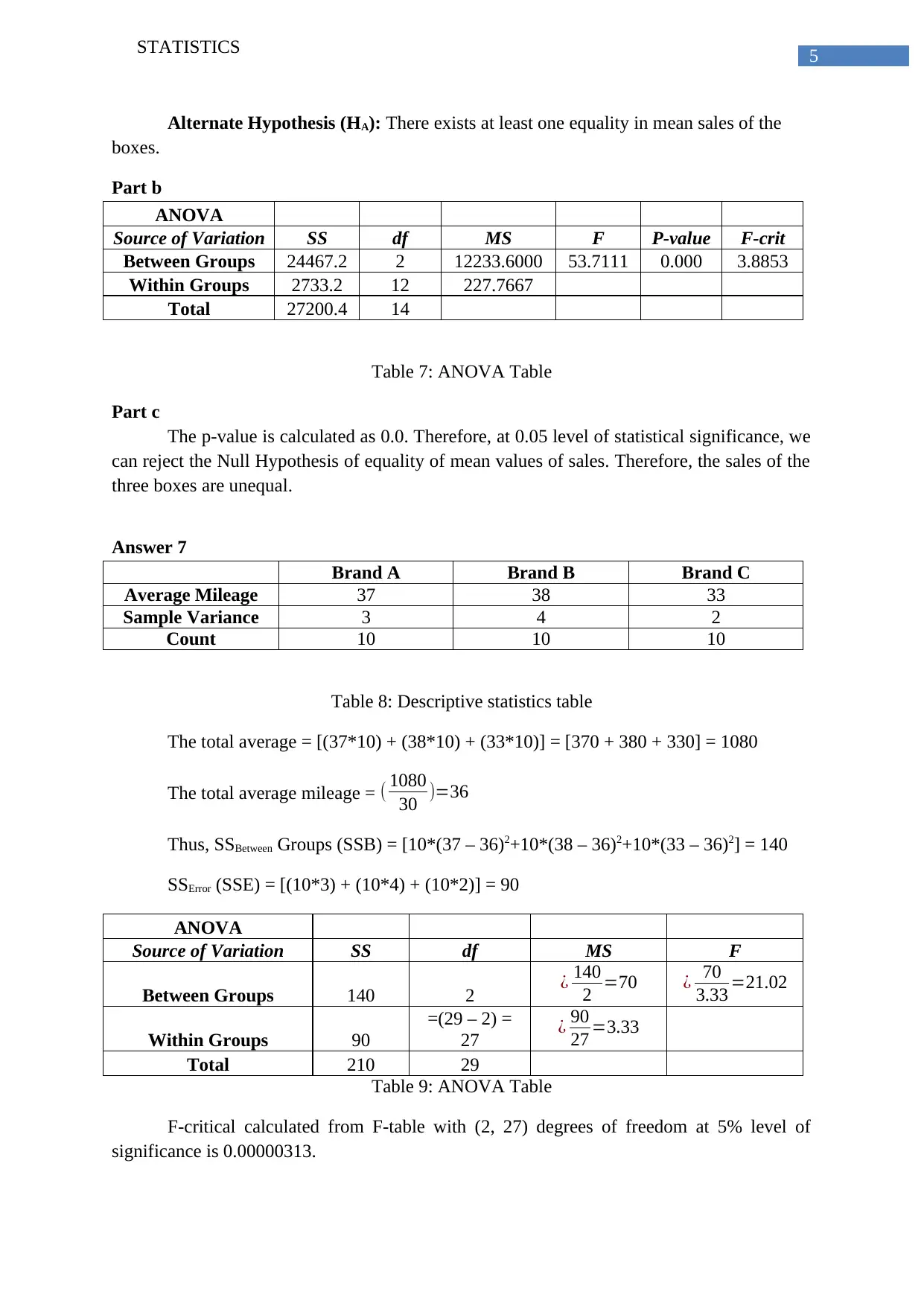
5STATISTICS
Alternate Hypothesis (HA): There exists at least one equality in mean sales of the
boxes.
Part b
ANOVA
Source of Variation SS df MS F P-value F-crit
Between Groups 24467.2 2 12233.6000 53.7111 0.000 3.8853
Within Groups 2733.2 12 227.7667
Total 27200.4 14
Table 7: ANOVA Table
Part c
The p-value is calculated as 0.0. Therefore, at 0.05 level of statistical significance, we
can reject the Null Hypothesis of equality of mean values of sales. Therefore, the sales of the
three boxes are unequal.
Answer 7
Brand A Brand B Brand C
Average Mileage 37 38 33
Sample Variance 3 4 2
Count 10 10 10
Table 8: Descriptive statistics table
The total average = [(37*10) + (38*10) + (33*10)] = [370 + 380 + 330] = 1080
The total average mileage = ( 1080
30 )=36
Thus, SSBetween Groups (SSB) = [10*(37 – 36)2+10*(38 – 36)2+10*(33 – 36)2] = 140
SSError (SSE) = [(10*3) + (10*4) + (10*2)] = 90
ANOVA
Source of Variation SS df MS F
Between Groups 140 2 ¿ 140
2 =70 ¿ 70
3.33 =21.02
Within Groups 90
=(29 – 2) =
27 ¿ 90
27 =3.33
Total 210 29
Table 9: ANOVA Table
F-critical calculated from F-table with (2, 27) degrees of freedom at 5% level of
significance is 0.00000313.
Alternate Hypothesis (HA): There exists at least one equality in mean sales of the
boxes.
Part b
ANOVA
Source of Variation SS df MS F P-value F-crit
Between Groups 24467.2 2 12233.6000 53.7111 0.000 3.8853
Within Groups 2733.2 12 227.7667
Total 27200.4 14
Table 7: ANOVA Table
Part c
The p-value is calculated as 0.0. Therefore, at 0.05 level of statistical significance, we
can reject the Null Hypothesis of equality of mean values of sales. Therefore, the sales of the
three boxes are unequal.
Answer 7
Brand A Brand B Brand C
Average Mileage 37 38 33
Sample Variance 3 4 2
Count 10 10 10
Table 8: Descriptive statistics table
The total average = [(37*10) + (38*10) + (33*10)] = [370 + 380 + 330] = 1080
The total average mileage = ( 1080
30 )=36
Thus, SSBetween Groups (SSB) = [10*(37 – 36)2+10*(38 – 36)2+10*(33 – 36)2] = 140
SSError (SSE) = [(10*3) + (10*4) + (10*2)] = 90
ANOVA
Source of Variation SS df MS F
Between Groups 140 2 ¿ 140
2 =70 ¿ 70
3.33 =21.02
Within Groups 90
=(29 – 2) =
27 ¿ 90
27 =3.33
Total 210 29
Table 9: ANOVA Table
F-critical calculated from F-table with (2, 27) degrees of freedom at 5% level of
significance is 0.00000313.
⊘ This is a preview!⊘
Do you want full access?
Subscribe today to unlock all pages.

Trusted by 1+ million students worldwide
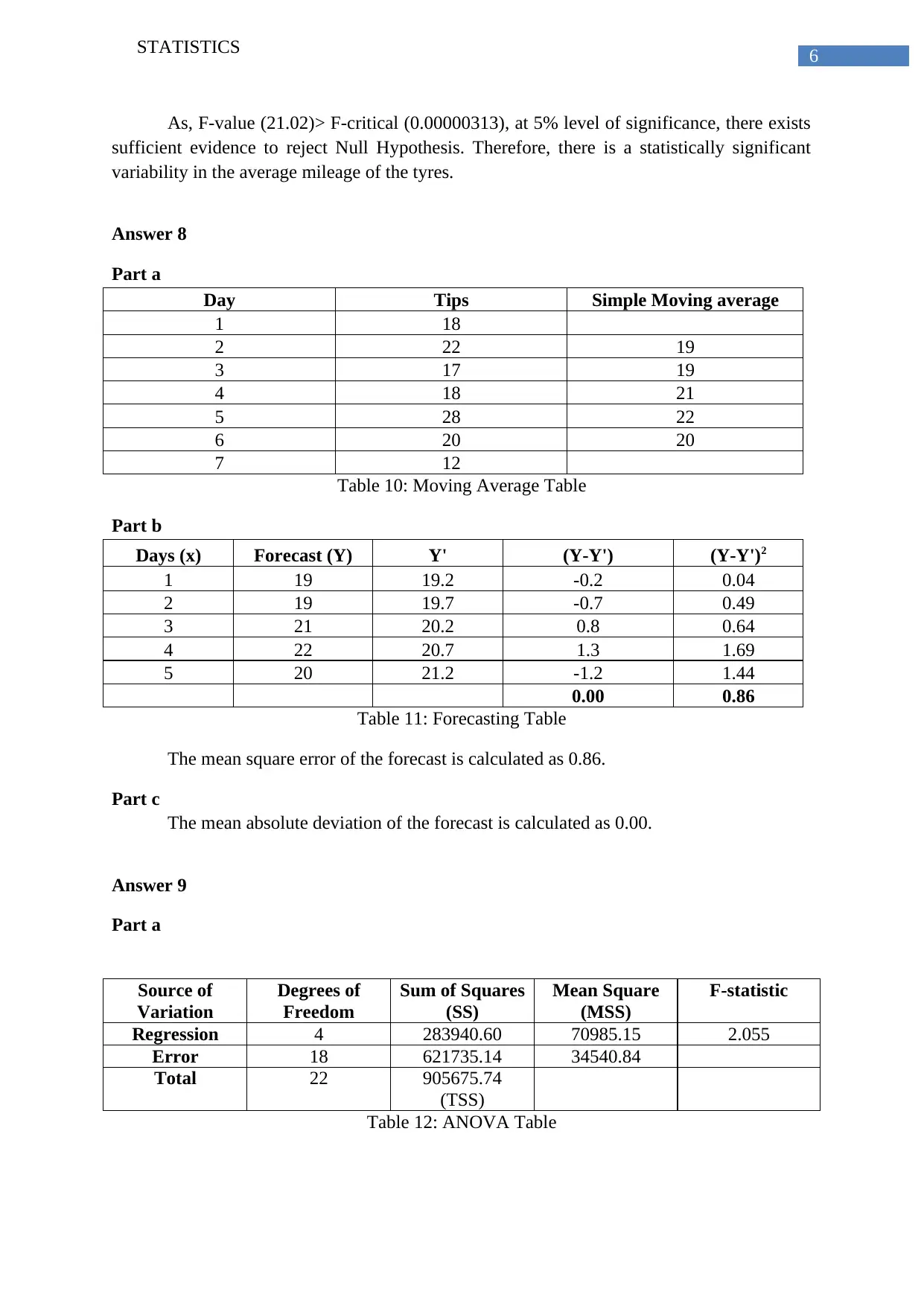
6STATISTICS
As, F-value (21.02)> F-critical (0.00000313), at 5% level of significance, there exists
sufficient evidence to reject Null Hypothesis. Therefore, there is a statistically significant
variability in the average mileage of the tyres.
Answer 8
Part a
Day Tips Simple Moving average
1 18
2 22 19
3 17 19
4 18 21
5 28 22
6 20 20
7 12
Table 10: Moving Average Table
Part b
Days (x) Forecast (Y) Y' (Y-Y') (Y-Y')2
1 19 19.2 -0.2 0.04
2 19 19.7 -0.7 0.49
3 21 20.2 0.8 0.64
4 22 20.7 1.3 1.69
5 20 21.2 -1.2 1.44
0.00 0.86
Table 11: Forecasting Table
The mean square error of the forecast is calculated as 0.86.
Part c
The mean absolute deviation of the forecast is calculated as 0.00.
Answer 9
Part a
Source of
Variation
Degrees of
Freedom
Sum of Squares
(SS)
Mean Square
(MSS)
F-statistic
Regression 4 283940.60 70985.15 2.055
Error 18 621735.14 34540.84
Total 22 905675.74
(TSS)
Table 12: ANOVA Table
As, F-value (21.02)> F-critical (0.00000313), at 5% level of significance, there exists
sufficient evidence to reject Null Hypothesis. Therefore, there is a statistically significant
variability in the average mileage of the tyres.
Answer 8
Part a
Day Tips Simple Moving average
1 18
2 22 19
3 17 19
4 18 21
5 28 22
6 20 20
7 12
Table 10: Moving Average Table
Part b
Days (x) Forecast (Y) Y' (Y-Y') (Y-Y')2
1 19 19.2 -0.2 0.04
2 19 19.7 -0.7 0.49
3 21 20.2 0.8 0.64
4 22 20.7 1.3 1.69
5 20 21.2 -1.2 1.44
0.00 0.86
Table 11: Forecasting Table
The mean square error of the forecast is calculated as 0.86.
Part c
The mean absolute deviation of the forecast is calculated as 0.00.
Answer 9
Part a
Source of
Variation
Degrees of
Freedom
Sum of Squares
(SS)
Mean Square
(MSS)
F-statistic
Regression 4 283940.60 70985.15 2.055
Error 18 621735.14 34540.84
Total 22 905675.74
(TSS)
Table 12: ANOVA Table
Paraphrase This Document
Need a fresh take? Get an instant paraphrase of this document with our AI Paraphraser
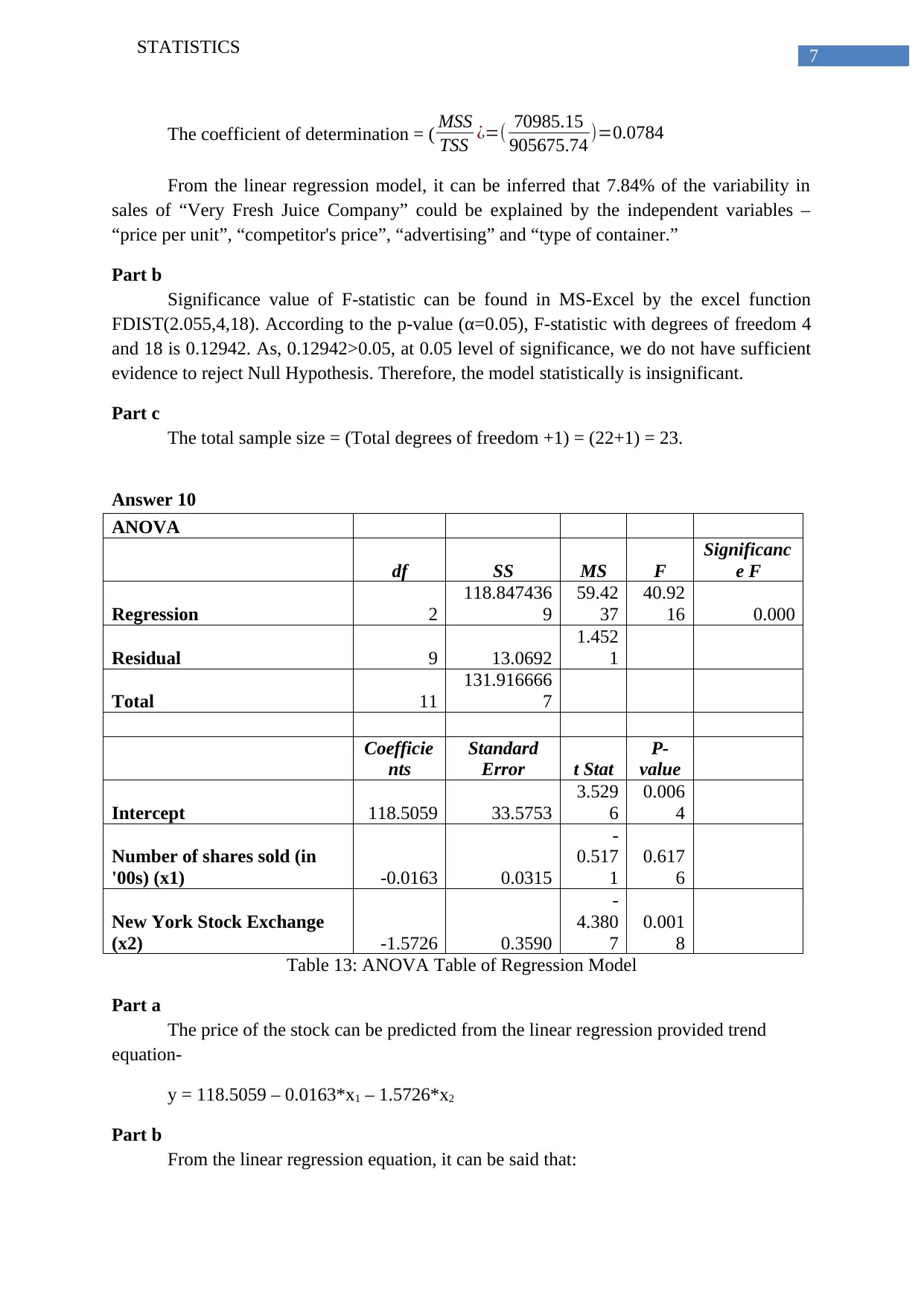
7STATISTICS
The coefficient of determination = ( MSS
TSS ¿=( 70985.15
905675.74 )=0.0784
From the linear regression model, it can be inferred that 7.84% of the variability in
sales of “Very Fresh Juice Company” could be explained by the independent variables –
“price per unit”, “competitor's price”, “advertising” and “type of container.”
Part b
Significance value of F-statistic can be found in MS-Excel by the excel function
FDIST(2.055,4,18). According to the p-value (α=0.05), F-statistic with degrees of freedom 4
and 18 is 0.12942. As, 0.12942>0.05, at 0.05 level of significance, we do not have sufficient
evidence to reject Null Hypothesis. Therefore, the model statistically is insignificant.
Part c
The total sample size = (Total degrees of freedom +1) = (22+1) = 23.
Answer 10
ANOVA
df SS MS F
Significanc
e F
Regression 2
118.847436
9
59.42
37
40.92
16 0.000
Residual 9 13.0692
1.452
1
Total 11
131.916666
7
Coefficie
nts
Standard
Error t Stat
P-
value
Intercept 118.5059 33.5753
3.529
6
0.006
4
Number of shares sold (in
'00s) (x1) -0.0163 0.0315
-
0.517
1
0.617
6
New York Stock Exchange
(x2) -1.5726 0.3590
-
4.380
7
0.001
8
Table 13: ANOVA Table of Regression Model
Part a
The price of the stock can be predicted from the linear regression provided trend
equation-
y = 118.5059 – 0.0163*x1 – 1.5726*x2
Part b
From the linear regression equation, it can be said that:
The coefficient of determination = ( MSS
TSS ¿=( 70985.15
905675.74 )=0.0784
From the linear regression model, it can be inferred that 7.84% of the variability in
sales of “Very Fresh Juice Company” could be explained by the independent variables –
“price per unit”, “competitor's price”, “advertising” and “type of container.”
Part b
Significance value of F-statistic can be found in MS-Excel by the excel function
FDIST(2.055,4,18). According to the p-value (α=0.05), F-statistic with degrees of freedom 4
and 18 is 0.12942. As, 0.12942>0.05, at 0.05 level of significance, we do not have sufficient
evidence to reject Null Hypothesis. Therefore, the model statistically is insignificant.
Part c
The total sample size = (Total degrees of freedom +1) = (22+1) = 23.
Answer 10
ANOVA
df SS MS F
Significanc
e F
Regression 2
118.847436
9
59.42
37
40.92
16 0.000
Residual 9 13.0692
1.452
1
Total 11
131.916666
7
Coefficie
nts
Standard
Error t Stat
P-
value
Intercept 118.5059 33.5753
3.529
6
0.006
4
Number of shares sold (in
'00s) (x1) -0.0163 0.0315
-
0.517
1
0.617
6
New York Stock Exchange
(x2) -1.5726 0.3590
-
4.380
7
0.001
8
Table 13: ANOVA Table of Regression Model
Part a
The price of the stock can be predicted from the linear regression provided trend
equation-
y = 118.5059 – 0.0163*x1 – 1.5726*x2
Part b
From the linear regression equation, it can be said that:
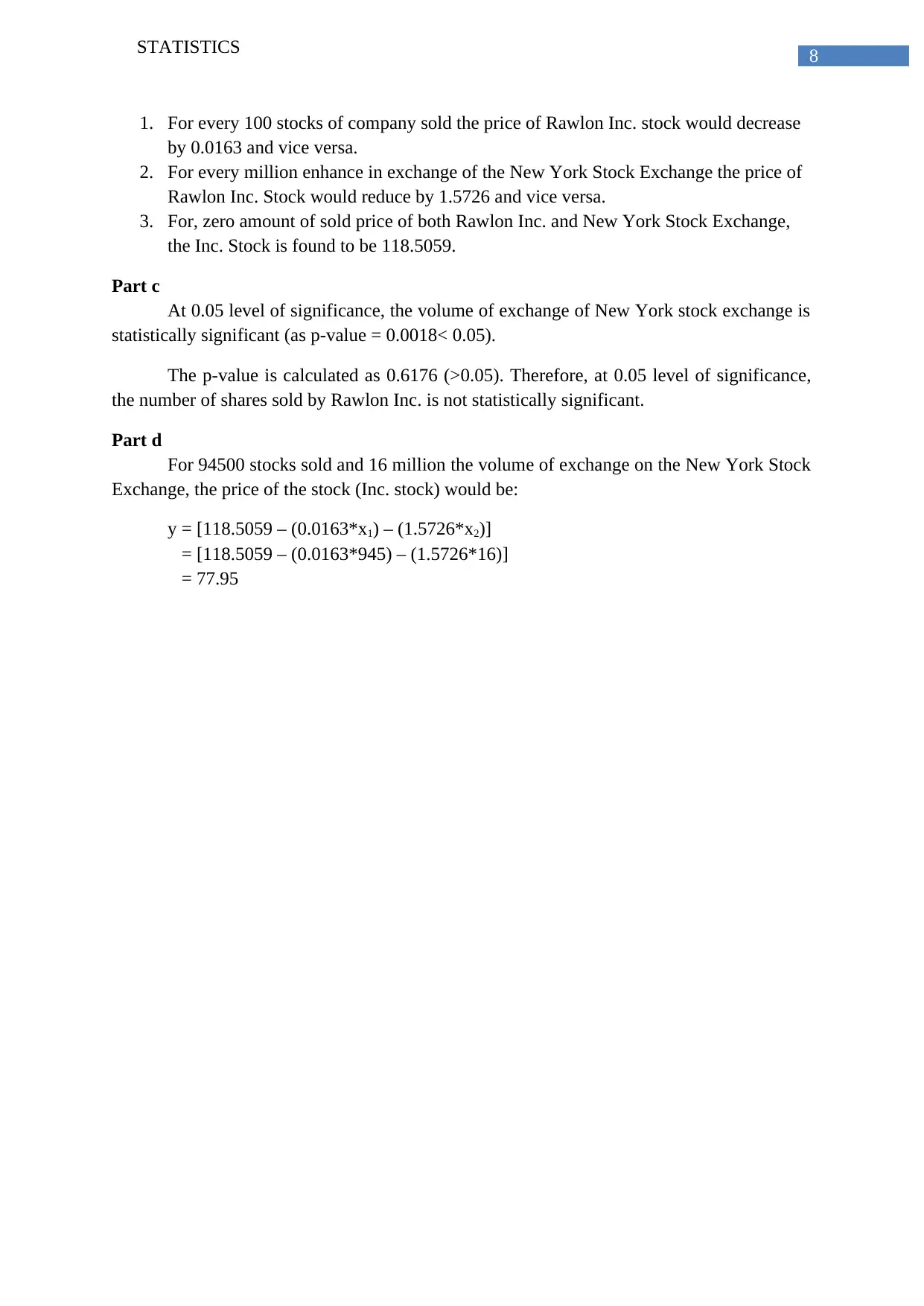
8STATISTICS
1. For every 100 stocks of company sold the price of Rawlon Inc. stock would decrease
by 0.0163 and vice versa.
2. For every million enhance in exchange of the New York Stock Exchange the price of
Rawlon Inc. Stock would reduce by 1.5726 and vice versa.
3. For, zero amount of sold price of both Rawlon Inc. and New York Stock Exchange,
the Inc. Stock is found to be 118.5059.
Part c
At 0.05 level of significance, the volume of exchange of New York stock exchange is
statistically significant (as p-value = 0.0018< 0.05).
The p-value is calculated as 0.6176 (>0.05). Therefore, at 0.05 level of significance,
the number of shares sold by Rawlon Inc. is not statistically significant.
Part d
For 94500 stocks sold and 16 million the volume of exchange on the New York Stock
Exchange, the price of the stock (Inc. stock) would be:
y = [118.5059 – (0.0163*x1) – (1.5726*x2)]
= [118.5059 – (0.0163*945) – (1.5726*16)]
= 77.95
1. For every 100 stocks of company sold the price of Rawlon Inc. stock would decrease
by 0.0163 and vice versa.
2. For every million enhance in exchange of the New York Stock Exchange the price of
Rawlon Inc. Stock would reduce by 1.5726 and vice versa.
3. For, zero amount of sold price of both Rawlon Inc. and New York Stock Exchange,
the Inc. Stock is found to be 118.5059.
Part c
At 0.05 level of significance, the volume of exchange of New York stock exchange is
statistically significant (as p-value = 0.0018< 0.05).
The p-value is calculated as 0.6176 (>0.05). Therefore, at 0.05 level of significance,
the number of shares sold by Rawlon Inc. is not statistically significant.
Part d
For 94500 stocks sold and 16 million the volume of exchange on the New York Stock
Exchange, the price of the stock (Inc. stock) would be:
y = [118.5059 – (0.0163*x1) – (1.5726*x2)]
= [118.5059 – (0.0163*945) – (1.5726*16)]
= 77.95
⊘ This is a preview!⊘
Do you want full access?
Subscribe today to unlock all pages.

Trusted by 1+ million students worldwide
1 out of 9
Related Documents
Your All-in-One AI-Powered Toolkit for Academic Success.
+13062052269
info@desklib.com
Available 24*7 on WhatsApp / Email
![[object Object]](/_next/static/media/star-bottom.7253800d.svg)
Unlock your academic potential
Copyright © 2020–2025 A2Z Services. All Rights Reserved. Developed and managed by ZUCOL.





